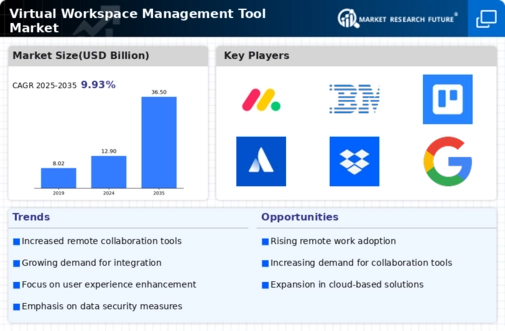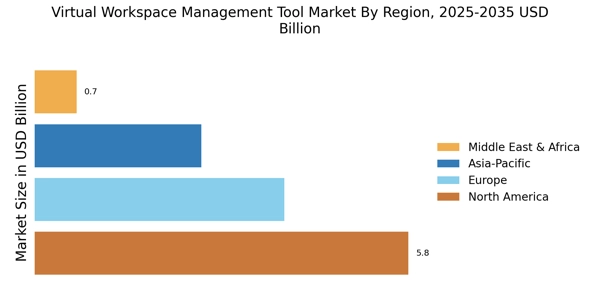Rise of Remote Work Culture
The rise of remote work culture is a pivotal driver for the Virtual Workspace Management Tool Market. As organizations increasingly adopt flexible work arrangements, the demand for tools that facilitate collaboration and productivity from various locations has surged. According to recent data, approximately 70% of employees now work remotely at least once a week, highlighting the necessity for effective virtual workspace solutions. This shift necessitates robust management tools that can streamline communication, project management, and file sharing, thereby enhancing overall efficiency. The Virtual Workspace Management Tool Market is likely to see continued growth as companies seek to optimize their remote work strategies, ensuring that employees remain engaged and productive regardless of their physical location.
Adoption of Cloud-Based Solutions
The adoption of cloud-based solutions is a significant driver for the Virtual Workspace Management Tool Market. As businesses increasingly migrate to cloud environments, the need for tools that can seamlessly integrate with these platforms has become paramount. Cloud-based virtual workspace management tools offer scalability, flexibility, and cost-effectiveness, making them attractive to organizations of all sizes. Recent statistics indicate that the cloud services market is projected to grow by over 20% annually, further fueling the demand for compatible management tools. This trend suggests that the Virtual Workspace Management Tool Market will continue to expand as companies seek to leverage cloud technology to enhance their operational efficiency and collaboration capabilities.
Growing Demand for Data Analytics
The growing demand for data analytics is reshaping the Virtual Workspace Management Tool Market. Organizations are increasingly recognizing the value of data-driven decision-making, which necessitates tools that can provide insights into team performance, project progress, and resource allocation. The integration of analytics features into virtual workspace management tools allows companies to monitor key performance indicators and optimize workflows. Research indicates that businesses utilizing data analytics can improve their operational efficiency by up to 30%. This trend underscores the importance of incorporating advanced analytics capabilities into virtual workspace management solutions, as organizations strive to enhance their competitive edge in an increasingly data-centric environment.
Increased Focus on Employee Well-Being
The growing emphasis on employee well-being is significantly influencing the Virtual Workspace Management Tool Market. Organizations are recognizing that a supportive work environment, even in virtual settings, is crucial for maintaining employee morale and productivity. Tools that promote mental health, work-life balance, and social interaction are becoming essential. Data suggests that companies investing in employee well-being initiatives experience a 25% increase in productivity. Consequently, the demand for virtual workspace management tools that incorporate features aimed at enhancing employee satisfaction is likely to rise. This trend indicates a shift towards more holistic approaches in workspace management, where the focus extends beyond mere task completion to encompass overall employee experience.
Emphasis on Collaboration and Communication
The emphasis on collaboration and communication is a critical driver for the Virtual Workspace Management Tool Market. As teams become more dispersed, the need for tools that facilitate seamless interaction and collaboration has intensified. Effective communication is essential for project success, and organizations are seeking solutions that can bridge the gap between remote team members. Recent findings suggest that companies with strong collaborative cultures are 5 times more likely to be high-performing. This statistic highlights the necessity for virtual workspace management tools that prioritize communication features, such as real-time messaging, video conferencing, and collaborative document editing. The ongoing demand for enhanced collaboration tools is likely to propel the growth of the Virtual Workspace Management Tool Market.


















Leave a Comment